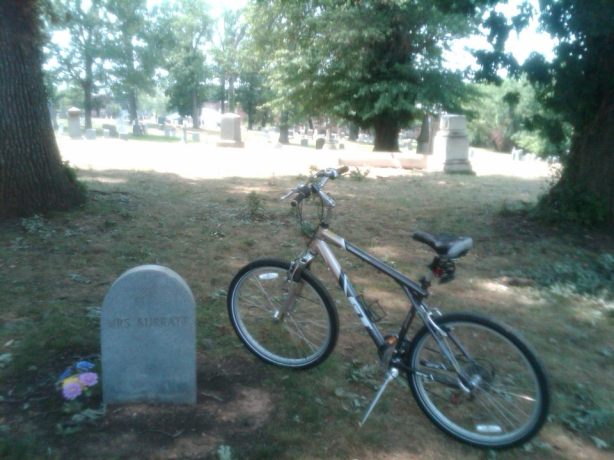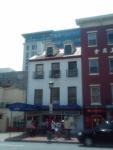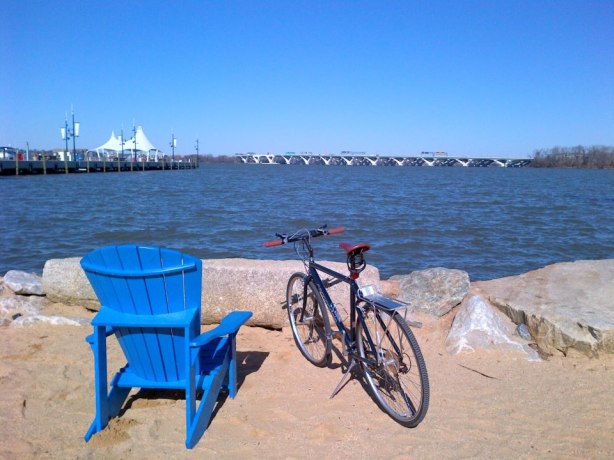
Battle of Bladensburg Marines Memorial
By the end of this long leisurely ride, or I should say the halfway point since I still needed to ride back to where I started, I found myself in Prince George’s County, Maryland. As I rode around taking in the area, I came upon Fort Lincoln Cemetery, and realized I had been here before. Located at 3401 Bladensburg Road in Colmar Manor, Maryland (MAP), I had previously discovered a number of historic sites on the cemetery grounds. These sites include Historic Fort Lincoln and The Old Springhouse, as well as the nearby Bladensburg Dueling Grounds, located just outside of the cemetery. With so many points of interest in the area, I decided to conduct some additional exploration and see what else I could find. And I wasn’t disappointed.
While riding around the expansive grounds within the cemetery, I saw what looked like a seating area behind the building with the mausoleum, which happens to be one of the grandest public mausoleums in the world. It is very large, open to the public, and contains a beautiful garden. So I decided to ride over to the seating are and take a break to relax. But as I got there and upon closer inspection I found out that it was, in fact, a memorial rather than just a place to sit. A stone marker at the entrance to the memorial reads, “This is the site of the Battle of Bladensburg. It was here that Commodore Barney and his marines were defeated in the War of 1812. The British moved on to burn the Capitol and White House.” I quickly pulled up some information on my cellphone. But naturally I was anxious to do more research and learn al about it later after I got home.
I learned that the Battle of Bladensburg was part of what was known as the Chesapeake Campaign of the War of 1812. As an aside, I have always the name odd inasmuch as the War of 1812 was fought over a nearly three-year period. Anyway, caused by British restrictions on U.S. trade and America’s desire to expand its territory, the United States took on the greatest naval power in the world, Great Britain.
Although neither side had gained a clear advantage in the first two years of the war, that changed in the spring of 1814 when Britain was able to disentangle itself from fighting France in the Napoleonic Wars. After Napoleon Bonaparte’s exile in April 1814, British forces in the war with America could now be replenished with thousands of veterans. These soldiers were different than the soldiers Americans had faced in Upper Canada; these men had fought against Napoleon and his Imperial Guard and wanted a quick end to this war against a young country.
The Battle of Bladensburg was fought on August 24, 1814, and America lost. And in large part due to the fortification of British forces with combat-experienced veterans, it was a significant loss for America. The defeat of General William Henry Winder and the 6,500 American men he had at his disposal allowed British Army Officer Robert Ross and his 4,500 men to subsequently march into nearby D.C.
President James Madison and his cabinet had already fled the city at that point, with Dolly Madison and White House slave Paul Jennings famously saving critical relics of their new republic, among them a portrait of George Washington. And it was a good thing that they did because the British promptly set fire to the city’s public buildings, including the presidential mansion (later to be rebuilt and renamed as The White House) and the U.S. Capitol Building over the following couple of days. The loss at the Battle of Bladensburg to a smaller but superior fighting force and the subsequent destruction of these symbols of American democracy devastated the morale of both American servicemen and the the public, and almost lead to the complete military defeat of the young American nation.
Ultimately, the War of 1812 ended in a draw on the battlefield, and the peace treaty reflected this. The Treaty of Ghent was signed in modern-day Belgium on December 24, 1814, and went into effect on February 17, 1815, after both sides had ratified it. And while Britain effectively won the War of 1812 by successfully defending its North American colonies, America also succeeded in not only maintaining it’s independence but expanding both U.S. trade and its territory as the country grew westward.
So who was the Commodore Barney mentioned on the inscription at the memorial? Joshua Barney was an American Navy officer who served in the Continental Navy during the Revolutionary War who later achieved the rank of commodore in the United States Navy. During his service in the War of 1812 he commanded the Chesapeake Bay Flotilla, a fleet of gunboats tasked with defending Chesapeake Bay. Concerned that Barney’s flotilla could fall into British hands, Secretary of the Navy John Paul Jones ordered Barney to take the flotilla as far up the Patuxent River as possible, to Queen Anne, and scuttle it if the British appeared. Leaving his barges with a skeleton crew to handle any destruction of the craft, Barney took the majority of his men to join the American Army commanded by General Winder where they participated in the Battle of Bladensburg.
Subsequent to narrowly avoiding capture prior to the battle, President James Madison personally directed the Marines led by Barney, making the Battle of Bladensburg one of only two instances of a sitting president exercised direct battlefield authority as Commander-in-Chief. The other was when George Washington personally crushed the Whiskey Rebellion.
Commodore Barney was severely wounded during the Battle of Bladensburg, receiving a bullet deep in his thigh that could never be removed. He later on December 10, 1818, from complications related to the wound. His remains rest in Allegheny Cemetery in Pittsburgh.
I find it unusual that a memorial was built about what was a disastrous defeat for the United States. But considering the dedication and bravery of men like Commodore Barney and the marines and other men who fought in that war, I think a memorial to them is fitting despite the loss at the Battle of Bladensburg.


[Click on the photos to view the full-size versions]
NOTE: The historic marker (see photo above) reads: “This is the site of the Battle of Bladensburg which took place in the War of 1812. Joshua Barney and his 500 marines were greatly outnumbered by the British expeditionary force of 4,500 trained regulars. The battle raged for four hours but eventually the overpowering numerical odds won out for the British who went on to burn the Capitol and the White House. On this location, Commodore Barney was wounded and taken prisoner. This memorial is in honor of Commodore Joshua Barney who made the supreme sacrifice in defense of his country and to his detachment of marines for their distinguished display of valor and gallantry.”
NOTE: The Battle of Bladensburg Marines Memorial is different than the more famous Battle of Bladensburg Memorial, which is located at the battlefield, that has been preserved under the Prince George’s County Department of Parks and Recreation, and is located in Waterfront Park, down the street between the Bladensburg Peace Cross and the George Washington House (two places I plan to ride to someday soon), at 4601 Annapolis Road in Bladensburg.



















